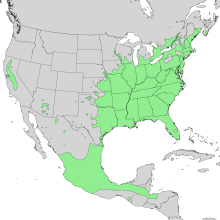Cephalanthus occidentalis
| Cephalanthus occidentalis | |
|---|---|

| |
| Cephalanthus occidentalis var. occidentalis blooming in Point Pelee National Park (Ontario, Canada). | |
| Scientific classification | |
| Kingdom: | Plantae |
| Clade: | Tracheophytes |
| Clade: | Angiosperms |
| Clade: | Eudicots |
| Clade: | Asterids |
| Order: | Gentianales |
| Family: | Rubiaceae |
| Genus: | Cephalanthus |
| Species: | C. occidentalis
|
| Binomial name | |
| Cephalanthus occidentalis | |
| Varieties | |
|
C. o. var. californicus | |

| |
| Natural range of Cephalanthus occidentalis[3] | |
Cephalanthus occidentalis is a species of flowering plant in the family Rubiaceae that is native to eastern and southern North America. Common names include buttonbush, common buttonbush, button-willow, buck brush, and honey-bells.
Description
[edit]Cephalanthus occidentalis is a deciduous shrub or small tree that averages 1–3 m (3.3–9.8 ft) in height, but can reach 6 m (20 ft). The leaves are opposite or in whorls of three, elliptic to ovate, 7–18 cm (2.8–7.1 in) long and 4–10 cm (1.6–3.9 in) broad, with a smooth edge and a short petiole. The flowers are arranged in a dense spherical inflorescence 2–3.5 cm (0.79–1.38 in) in diameter on a short peduncle. Each flower has a fused white to pale yellow four-lobed corolla forming a long slender tube connecting to the sepals. The stigma protrudes slightly from the corolla. The fruit is a spherical cluster of achenes (nutlets).[4]
-
Leaves opposite or in whorls of three; inflorescences may be in clusters
-
Flower buds
-
Aged flowers
-
Infructescence, a cluster of achenes
Taxonomy
[edit]There are two varieties, not considered distinct by all authorities:
- Cephalanthus occidentalis var. occidentalis (syn. var. pubescens) – common buttonbush. Eastern North America from Nova Scotia west to Minnesota and south to Florida and east Texas.
- Cephalanthus occidentalis var. californicus – California button-willow. Southwestern North America, from west Texas west to California (Sierra Nevada foothills, San Joaquin Valley, Sacramento Valley, and the Inner North Coast Ranges) and south to Mexico and Central America.
Habitat
[edit]Buttonbush is a common shrub of many wetland habitats in its range, including swamps, floodplains, mangrove, pocosin, riparian zones, and moist forest understory.[5] It is a member of the flora in the Everglades.[5]
Ecology
[edit]Waterfowl and other birds eat the seeds. Wood ducks utilize the plant as nest protection, and mallards eat the fruit.[6] Deer browse the foliage, which is poisonous to livestock.[7] Insects and hummingbirds take the nectar, with bees using it to make honey.[5][8] It is a larval host to the hydrangea sphinx, the royal walnut moth, and the titan sphinx.[9]
Distribution
[edit]The species occurs in eastern North America with disjunct populations occurring in the west. In Canada, it occurs from southern Ontario and Quebec east to New Brunswick and south-western Nova Scotia. Besides the eastern United States, and eastern regions of the Midwest, notable areas range into Arizona, the Mogollon Rim, and other mountain ranges; in California, the entire San Joaquin Valley[10] West of the Great Plains and the Rocky Mountains, only western Texas, Arizona, and California find C. occidentalis.
Uses
[edit]Medicinal
[edit]Cephalanthus occidentalis has a number of historical medicinal uses, but it is also toxic due to the presence of cephalanthin.[5][8]
Cultivation
[edit]Buttonbush is cultivated as an ornamental plant for a nectar source or 'honey plant' and for aesthetics in gardens and native plant landscapes, and is planted on slopes to help control erosion.[11] Buttonbush is a suitable shrub for butterfly gardens.
San Joaquin Valley landmark tree
[edit]The town of Buttonwillow, California was named for the buttonbush (Cephalanthus occidentalis). A lone buttonbush served as a landmark on an old trans-San Joaquin Valley trail, and was used by ancient Yokuts as a meeting place. It later became the site of settlers' stock rodeos. This buttonbush tree is listed as California Historical Landmark No. 492, and is now known as the "Buttonwillow Tree".[12]
References
[edit]- ^ Maiz-Tome, L. (2016). "Cephalanthus occidentalis". IUCN Red List of Threatened Species. 2016: e.T64310261A67729125. doi:10.2305/IUCN.UK.2016-1.RLTS.T64310261A67729125.en. Retrieved 6 May 2020.
- ^ "Cephalanthus occidentalis". Germplasm Resources Information Network. Agricultural Research Service, United States Department of Agriculture. Retrieved 2010-01-04.
- ^ "Cephalanthus occidentalis" (PDF). Digital Representations of Tree Species Range Maps from "Atlas of United States Trees" by Elbert L. Little, Jr. (and other publications). United States Geological Survey.
- ^ "Cephalanthus occidentalis L. buttonbush" (PDF). Wildland Shrubs of the United States and its Territories: Thamnic Descriptions. United States Forest Service. Archived from the original (PDF) on 26 March 2009. Retrieved 2009-09-14.
- ^ a b c d "Cephalanthus occidentalis". Fire Effects Information System. United States Forest Service.
- ^ Niering, William A.; Olmstead, Nancy C. (1985) [1979]. The Audubon Society Field Guide to North American Wildflowers, Eastern Region. Knopf. p. 764. ISBN 0-394-50432-1.
- ^ Little, Elbert L. (1980). The Audubon Society Field Guide to North American Trees: Eastern Region. New York: Knopf. p. 667. ISBN 0-394-50760-6.
- ^ a b "Common Buttonbush Cephalanthus occidentalis L." (PDF). Natural Resources Conservation Service Plant Guide. United States Department of Agriculture.
- ^ The Xerces Society (2016), Gardening for Butterflies: How You Can Attract and Protect Beautiful, Beneficial Insects, Timber Press.
- ^ Little Jr., Elbert L. (1976). "Map 34, Cephalanthus occidentalis". Atlas of United States Trees. Vol. 3 (Minor Western Hardwoods). US Government Printing Office. LCCN 79-653298. OCLC 4053799.
- ^ O'Sullivan, Penelope (2007). The Homeowner's Complete Tree & Shrub Handbook: The Essential Guide to Choosing, Planting, and Maintaining Perfect Landscape Plants. Storey Publishing. p. 197. ISBN 978-1-58017-571-5.
- ^ "CHL # 492 Buttonwillow Tree Kern". www.californiahistoricallandmarks.com.
External links
[edit]Text is available under the CC BY-SA 4.0 license; additional terms may apply.
Images, videos and audio are available under their respective licenses.





